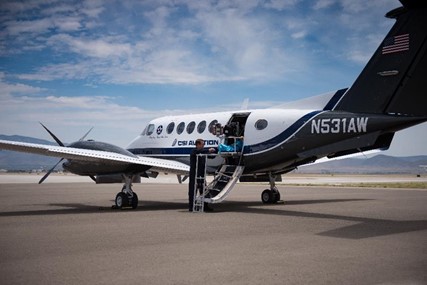Prepping a patient for transport mostly involves gathering all the information our medical crew and flight team will need to continue providing the highest quality of care. To successfully prepare a patient for transport, call CSI Aviation and indicate the following information:
- Sending Facility Information:
We need to know where the patient is currently located—all the way down to their hospital unit room number. We will also need a contact number for that unit as well as the name and contact information of someone providing direct care for the patient.
- Receiving Facility Information:
The same information provided by the sending facility is needed regarding the receiving facility. This includes the patient’s intended room number and unit, and the name of the receiving doctor.
- Patient Information:
We strive to provide the highest level of care possible to our patients. To do so, we need some crucial information before booking their flight. To create the best mobile ICU environment from the air here is what you will need to tell us when you call:
- Name: High-quality care includes bedside manner. Our medical crew wants to know your patient’s name so they can engage with them on a personal level (and guarantee we’re transporting the correct patient!)
- Weight: In aviation, weight is related to how much fuel is needed for a flight. In addition to the weight of our equipment, pilots, and medical staff, we need to know the weight of the patient and any other rider on board the aircraft to correctly measure flight time and fuel stops. Additionally, weight is used to calculate various medications and interventions and provides a more complete picture of what we might be dealing with.
- Gender
- Date of Birth: Age is needed for both medical and legal assessments; preventing any errors in patient identification and determining an accurate patient picture; and is required for billing purposes
- Diagnosis: Indicate the diagnosis of the sending hospital doctor. We need to confirm that the patient’s condition fits within our scope of practice.
- Is there another rider?
- If the patient is a minor or has a family member or someone else traveling with them, we need their name, weight, and date of birth as well.
- Is the patient intubated?
- We transport intubated patients, but we need to know beforehand.
- We carry approximately 200 lbs. of gear on the aircraft, but it is unnecessary to bring all that equipment to each patient. If a patient is already intubated, we won’t switch anything out for transport. Pre-judging precisely what equipment is required facilitates a speedy and appropriate transfer.
- Type of IV Drips: To maintain patient stability, we need to know exactly what to give them for the duration of their flight. We can handle any infusions a patient has; we just have to know what they are beforehand. The sending hospital may need to provide additional medication for the transfer if it is not one we already carry.
- Are there any special considerations or equipment?
- We can transport nearly all patients, and we’ll be the first to tell you if we can’t. If your patient has a unique situation, please let us know what they need for optimal care, and we’ll be sure to provide it.

- Ground Transportation
In addition to handling all the aspects of the medical flight itself, CSI Aviation will also coordinate ground transport between hospitals and the runway. We connect directly with ambulance companies to make sure your patient gets to and from the airplane safely.
- Send CSI Transfer Packet
When you call us, we will send a transfer packet to be filled out. It details most of the above-stated information while also going into more specifics. Many hospitals we have worked with before have a number of these packets on hand. We also have one available for download here.
- On our “Physician Certification Statement” you will be asked to indicate the necessity for transfer based on our scope of practice as well as why the patient needs to be moved from your facility. Reasons for transport to receiving hospital include:
- It is the closest appropriate facility for the level of care needed.
- All closer facilities lack bed space or specialty services needed.
- Ground transport time to the closest facility is too long due to the patient’s condition.
- Ground transport is not appropriate or is unavailable for the level of care needed.
- Weather does not allow means for transport to the closest facility.
Once you have secured the need for patient transport over the phone with us, you will need to fill out some forms in more detail, indicating:
- Transfer Information:
- At least 2 copies of Patient Face Sheet (preferably 4 copies so our whole team has one.)
- Signed EMTALA Form from Sending Facility
- Signed CSI HIPPA/Consent Form
- Optional:
- Copies of Films/CT/MRI/X-Rays
- Copies of Lab Results
- Copy of Chart for Receiving Facility
- For Prepping the Patient for Flight:
- IV Access (2 sites preferred)
- Airway Control (consider early intubation)
- NG/OG Tube (if required)
- Foley Catheter (if required)
- Chest Tube (if indicated)
- Would Dressing/Splints
- Blood Products (if indicated)
We will need to know whether any of the above apply to your patient in order to provide the highest level of care before, during, and after the flight.



